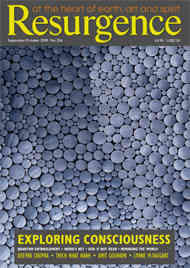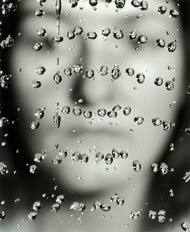A paradigm shift in science is taking place. This shift is taking us from a divisive, God-denying, matter-based science to one that integrates science and God or spirituality. This new scientific paradigm rests on solid theory-based quantum physics and solid evidence-based empirical data, not on fanciful ideas. And like all creative endeavours, the paradigm shift has come with a surprise: that science itself has to operate within a spiritual metaphysics.
In the 1980s there was strong emphasis on the ‘holistic paradigm’ which incorporated ‘pantheism’ or Nature-based spirituality. Holistic thinkers dominated such avant-garde thinking: Gregory Bateson, Fritjof Capra, Eric Wantsch, Francisco Varela, Humberto Maturana, John Lilly, Ilya Prigogine, Karl Pribram, David Bohm, Ervin László, and Roger Sperry. The list is very distinguished and very long. According to holism, the whole is greater than the sum of the parts. It is greater because the emergence of novel phenomena cannot be reduced to the sum of its parts. Life, mind, consciousness, spirituality – all were explained as the holistic emergent phenomena of matter. Although holism was an integrative view, most holistic thinkers and writers still believed that everything was made of matter. Holism was not the only integrative track. Depth psychologists, starting with Freud and Jung, were openly positing the concept of the ‘collective unconscious’ that presupposed an irreducible consciousness.
Many holistic thinkers such as Capra depended on systems theory for their analysis; however, the scope of this kind of analysis is limited, as only generalities can be discussed. Others, Pribram, Bohm and Edgar Mitchell among them, expounded the idea of ‘hologram’, both literally and metaphorically. But the hologram is an object, whereas consciousness has both subject and object aspects. So how does subject-object awareness come about? This ‘hard question’ cannot be addressed from a materialist point of view.
Spirituality is more than pantheism, and an integrative theoretical foundation to provide a bridge between holistic thinking within science and psychological thinking within consciousness was lacking. Such a foundation came about only when quantum physics was properly interpreted in a paradox-free way.
QUANTUM PHYSICISTS, OF which I am one, were not exactly silent while all the earlier work on a paradigm shift was going on. The mathematician John von Neumann was the first to interject consciousness into physics by positing that consciousness “chooses” the actual event of experience from all the quantum possibilities. He explains that the observer affects the observed. By simply looking, observers are able to convert quantum possibilities into actual events of experience. In the 1970s, the physicist Fred Alan Wolf popularised von Neumann’s idea with the truism “We create our own reality”.
The seriousness of von Neumann’s idea can be appreciated only when we engage with the so-called quantum measurement paradox, a most disagreeable thorn in the side of materialist attempts to understand and interpret quantum physics. In the materialist model, elementary particles make atoms, atoms make molecules, molecules make cells, cells make brains, and brains make consciousness. This is called ‘upward causation’. However, according to quantum physics, since all objects are quantum possibilities, in such a view possible elementary particles make possible atoms all the way to making a possible brain and possible consciousness.
How can a possible consciousness coupled to possibilities of an object give us an actual event? Possibility coupled to possibility gives only greater possibility. So materialist thinking about consciousness cannot explain the observer effect – this is the quantum measurement paradox. Hence von Neumann’s idea: since material interactions cannot change possibility into actuality, our consciousness must be non-material to be able to do so.
But the materialists’ objection to von Neumann’s approach to quantum measurement is also sound: how does consciousness, if it is an independent, non-material, dual object, interact with a material object? Such an interaction must require the mediation of signals carrying energy. But the energy of the physical universe alone is always constant, precluding any such mediation. A paradox again: the paradox of dualism.
The breakthrough idea is that consciousness is neither a material brain-product nor a dual object; instead, consciousness is the ground of all being in which material objects exist as possibilities. In the event of quantum measurement, consciousness (in the form of the observer) chooses from all the offered possibilities the actuality that it experiences. In other words, conscious choice is responsible for manifesting both the proverbial falling tree in the forest and the ‘you’ who hears the sound of the fall. No observer: no sound; not even a tree.
CRUCIAL TO THE breakthrough of this ‘primacy-of-consciousness’ interpretation of quantum physics is the resolution of another paradox: when two observers are simultaneously choosing among conflicting choices, who gets to choose so that pandemonium can be avoided? Three physicists working independently resolved the paradox: Ludwig Bass, Casey Blood and myself. We all proposed ‘non-locality’– the ‘signalless’ interconnectedness of the choosing consciousness – as the solution. We don’t choose with total freedom from our individual local ego consciousness, but from a non-local, cosmic, non-ordinary state of consciousness. Let’s call this ‘quantum consciousness’.
This is a breakthrough idea on several scores. First, a non-local consciousness is objective and its choice for an objective consensus situation of many objects and/or many events is objective. This validates why quantum physics is able to predict probabilities accurately. Second, for a single event, the scope of creativity remains. The secret is that we must choose creatively in synchrony with quantum consciousness to manifest our intentions. In our ego, our so-called free will is seriously compromised, having become a choice between conditioned alternatives: “What flavour ice cream do you want? Chocolate or vanilla?” That kind of choice. Third, the non-locality of the choosing consciousness is an experimentally verifiable idea.
In 1982, the physician Larry Dossey, in his book Space, Time and Medicine, discussed the efficacy of quantum non-locality in healing, an idea that was verified in 1988 by Randolph Byrd, who demonstrated the causal efficacy of non-local consciousness and ‘downward causation’– mind over matter – in prayer healing at a distance. Three years later, I published my papers on quantum creativity and the idealist interpretation of quantum physics in which ‘God’ (think of God as a higher state of consciousness from which our free choices are made) was rediscovered in the form of downward causation with quantum consciousness as its agent.
Quantum creativity reveals another important aspect of downward causation – or mind over matter – besides non-locality; the idea of discontinuity. Creative ideas come to us via discontinuous events of insight. This is anathema to old paradigm thinking, in which all phenomena are material phenomena, and material interactions are continuous. But in the primacy-of-consciousness paradigm, the discontinuity of creativity is explained as ‘quantum leaps’ similar to the jumps an electron makes from one atomic orbit to another without going through the intervening space.
In 1989, in his book Quantum Healing, the physician Deepak Chopra independently suggested quantum consciousness and the presence of discontinuity in downward causation. He discussed his revolutionary idea of quantum healing as due to quantum leaps in consciousness. Science within consciousness was on the way.
WE ARE WITNESSING science’s rediscovery of God and downward causation. Besides the wisdom of spiritual traditions, holistic thinking, new psychology and quantum physics, there have been other developments that suggest that something more than materialism may be in the offing in science. In 1981, biologist Rupert Sheldrake’s revolutionary book A New Science of Life was published, revitalising the once-discarded notion of the vital body. Sheldrake correctly theorised that the vital body is the reservoir of non-local and non-physical morphogenetic fields used for biological form building.
Then in 1994 the philosopher John Searle published his book The Rediscovery of the Mind, which physicist Roger Penrose supported with rigorous mathematics in his own book The Emperor’s New Mind. Both researchers showed that matter cannot process meaning: only a non-physical mind can and does.
Empirical data in support of subtle bodies was also accumulating. The near-death researchers made breakthroughs proving survival (of subtle bodies) after the (temporary) death of the physical body. Cardiologist Michael Sabom’s book Recollections of Death expands on this theme. The psychiatrist Stanislav Grof discovered a new technique of “holotropic breathing” for recalling and codifying reincarnational memory which until then could be verified only by following up on children’s recollections.
This work gave science within consciousness new power and new horizons to integrate. One is the physics of survival and reincarnation. What survives? What reincarnates? The subtle bodies, of course: in truth, their conditioned quantum mathematics of possibilities. The insight of quantum healing is part of the creative process of quantum consciousness.
In the 1980s, the ‘organismic’ school of biology (those biologists who ascribe causal efficacy to the entire organism, not merely to the genes), led by Brian Goodwin, Mae-Wan Ho and Peter Saunders, kept reminding the scientific community of the incompleteness of Darwinism even in its latest revision, neo-Darwinism.
The astrophysicist Arne Wyller, in his book The Creating Consciousness, published in 1999, suggested that consciousness plays the crucial role in evolution. And finally, in a recent book, Creative Evolution, I have been able to build a bridge between neo-Darwinism, the intelligent design theory of evolution, and the organismic theories using the ideas of creative downward causation and subtle bodies. The crucial idea here is that the famous ‘fossil gaps’ of macroevolution (called ‘punctuation marks’ by palaeontologists) are the results of quantum leaps of biological creativity.
This way of looking at evolution provides a scientific basis for earlier revolutionary ideas about our evolutionary future (as evolution toward Godliness) by such luminaries as the Jesuit monk Teilhard de Chardin and the mystic/philosopher Sri Aurobindo.
SO GOD IS not dead! The last time I was in London, I noticed adverts paid for by materialists/atheists on London double-decker buses: “God probably does not exist, so don’t worry and enjoy life.” The hidden message is “Don’t worry about punishment from God for your ‘sins’, be hedonistic.” But a strong case for the existence of God has been made and the materialists are obviously a bit too hasty in their assertions!
If God probably does exist, what should we do about it? Try to become ‘good’ or else God will punish us? No. Try to become good because that’s where the evolution of consciousness is taking us.
The evolution of consciousness is taking us towards greater and greater capacity for processing the meaning of our lives and the world around us. The immediate future of evolution is promising to take us from our current preoccupation with the rational mind to an intuitive mind. Such evolution values meaning, such as goodness, beauty, truth, justice and love.
So the goal of every ‘God aficionado’ is to explore quantum possibilities and manifest these archetypes – goodness, beauty, truth, justice, and love – in his or her life as far as possible. The means one uses to achieve this goal are threefold: right thinking, right living and right livelihood.
Right thinking consists of understanding the paradigm shift and helping others to do so. Right living consists of ‘walking our talk’, manifesting our understanding in how we live, becoming guiding examples for others. This will take many quantum leaps, openness to non-locality, and the desire to change hierarchical relationships into ‘tangled’ ones. And right livelihood consists of earning our living in a way that is congruent with our modes of thinking and living, and helping our entire society to achieve this congruence.
When we live with right thinking, right living and right livelihood at the centre of our lives, we can use the transformative aspects of quantum physics to transform ourselves and our society, no less. •








